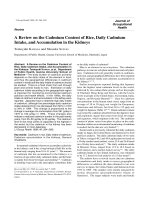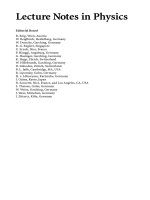- Trang chủ >>
- Khoa Học Tự Nhiên >>
- Vật lý
Physics of the Impossible: A Scientific Exploration into the World of Phasers, Force Fields, Teleportation, and Time Travel
Bạn đang xem bản rút gọn của tài liệu. Xem và tải ngay bản đầy đủ của tài liệu tại đây (2.91 MB, 353 trang )
This book has been optimized for viewing
at a monitor setting of 1024 x 768 pixels. Other books by Michio Kaku
PARALLEL WORLDS
EINSTEIN'S COSMOS
VISIONS
HYPERSPACE
BEYOND EINSTEIN
A SCIENTIFIC EXPLORATION
INTO THE WORLD OF PHASERS, FORCE FIELDS,
TELEPORTATION, AND TIME TRAVEL
Doubleday
NEW YORK LONDON TORONTO SYDNEY AUCKLAND
PUBLISHED BY DOUBLEDAY
Copyright © 2008 by Michio Raku
All Rights Reserved
Published in the United States by Doubleday, an imprint of
The Doubleday Broadway Publishing Group, a division
of Random House, Inc., New York.
\Y\Y w. d o u b 1 eday. co m
DOUBLEDAY and the portrayal of an anchor with a dolphin
are registered trademarks of Random House, Inc.
Library of Congress Cataloging-in-Publication Data
Kaku, Michio.
Physics of the impossible : a scientific exploration into the world of phasers, force
fields, teleportation, and time travel / Michio Raku. -1st ed.
p. cm.
Includes bibliographical references and index.
1. Physics-Miscellanea. 2. Science-Miscellanea. 3. Mathematical physics-
Miscellanea. 4. Physics in literature. 5. Human-machine systems. I. Title.
QC75.R18 2008
530-dc25
2007030290
elSBN: 978-0-385-52544-2
vl.O
To my loving wife, Shizue,
and to
Michelle and Alyson
Preface i\
ichnou lodgments
\ i x
Port I: Class I Impossibilities
1: Force Fields 3
2: Invisibility 16
3: Phasers and Death Stars 34
4: Teleportation 53
5: Telepathy 70
6: Psychokinesis 88
7: Robots 103
8: Extraterrestrials and UFOs 126
9: Starships 154
10: Antimatter and Anti-universes 179
Part II: Class II Impossibilities
11: Faster Than Light 197
12: Time Travel 216
13: Parallel Universes 229
Port III: Class III Impossibilities
14: Perpetual Motion Machines 257
15: Precognition 272
Epilogue: The Future of the Impossible 284
Notes 305
Bibliography 317
Index 319
If at first an idea does not sound absurd,
then there is no hope for it.
-ALBERT EINSTEIN
One day, would it be possible to walk through walls? To build starships
that can travel faster than the speed of light? To read other people's
minds? To become invisible? To move objects with the power of our
minds? To transport our bodies instantly through outer space?
Since I was a child, I've always been fascinated by these questions.
Like many physicists, when I was growing up, I was mesmerized by
the possibility of time travel, ray guns, force fields, parallel universes,
and the like. Magic, fantasy, science fiction were all a gigantic play-
ground for my imagination. They began my lifelong love affair with the
impossible.
I remember watching the old Flash Gordon reruns on TV. Every
Saturday, I was glued to the TV set, marveling at the adventures of
Flash, Dr. Zarkov, and Dale Arden and their dazzling array of futuris-
tic technology: the rocket ships, invisibility shields, ray guns, and cities
in the sky. I never missed a week. The program opened up an entirely
new world for me. I was thrilled by the thought of one day rocketing to
an alien planet and exploring its strange terrain. Being pulled into the
orbit of these fantastic inventions I knew that my own destiny was
x PREFACE
somehow wrapped up with the marvels of the science that the show
promised.
As it turns out, I was not alone. Many highly accomplished scien-
tists originally became interested in science through exposure to sci-
ence fiction. The great astronomer Edwin Hubble was fascinated by
the works of Jules Verne. As a result of reading Verne's work, Hubble
abandoned a promising career in law, and, disobeying his father's
wishes, set off on a career in science. He eventually became the great-
est astronomer of the twentieth century. Carl Sagan, noted astronomer
and bestselling author, found his imagination set afire by reading
Edgar Rice Burroughs's John Carter of Mars novels. Like John Carter,
he dreamed of one day exploring the sands of Mars.
I was just a child the day when Albert Einstein died, but I remem-
ber people talking about his life, and death, in hushed tones. The next
day I saw in the newspapers a picture of his desk, with the unfinished
manuscript of his greatest, unfinished work. I asked myself, What
could be so important that the greatest scientist of our time could not
finish it? The article claimed that Einstein had an impossible dream, a
problem so difficult that it was not possible for a mortal to finish it. It
took me years to find out what that manuscript was about: a grand,
unifying "theory of everything." His dream-which consumed the last
three decades of his life-helped me to focus my own imagination. I
wanted, in some small way, to be part of the effort to complete Ein-
stein's work, to unify the laws of physics into a single theory.
As I grew older I began to realize that although Flash Gordon was
the hero and always got the girl, it was the scientist who actually made
the TV series work. Without Dr. Zarkov, there would be no rocket ship,
no trips to Mongo, no saving Earth. Heroics aside, without science
there is no science fiction.
I came to realize that these tales were simply impossible in terms
of the science involved, just flights of the imagination. Growing up
meant putting away such fantasy. In real life, I was told, one had to
abandon the impossible and embrace the practical.
However, I concluded that if I was to continue my fascination with
the impossible, the key was through the realm of physics. Without a
PREFACE x.
solid background in advanced physics, I would be forever speculating
about futuristic technologies without understanding whether or not
they were possible. I realized I needed to immerse myself in advanced
mathematics and learn theoretical physics. So that is what I did.
In high school for my science fair project I assembled an atom
smasher in my mom's garage. I went to the Westinghouse company
and gathered 400 pounds of scrap transformer steel. Over Christmas I
wound 22 miles of copper wire on the high school football field. Even-
tually I built a 2.3-million-electron-volt betatron particle accelerator,
which consumed 6 kilowatts of power (the entire output of my house)
and generated a magnetic field of 20,000 times the Earth's magnetic
field. The goal was to generate a beam of gamma rays powerful
enough to create antimatter.
My science fair project took me to the National Science Fair and
eventually fulfilled my dream, winning a scholarship to Harvard, where
I could finally pursue my goal of becoming a theoretical physicist and
follow in the footsteps of my role model, Albert Einstein.
Today I receive e-mails from science fiction writers and screen-
writers asking me to help them sharpen their own tales by exploring
the limits of the laws of physics.
THE "IMPOSSIBLE" IS RELATIVE
As a physicist, I have learned that the "impossible" is often a relative
term. Growing up, I remember my teacher one day walking up to the
map of the Earth on the wall and pointing out the coastlines of South
America and Africa. Wasn't it an odd coincidence, she said, that the
two coastlines fit together, almost like a jigsaw puzzle? Some scientists,
she said, speculated that perhaps they were once part of the same, vast
continent. But that was silly. No force could possibly push two gigantic
continents apart. Such thinking was impossible, she concluded.
Later that year we studied the dinosaurs. Wasn't it strange, our
teacher told us, that the dinosaurs dominated the Earth for millions of
years, and then one day they all vanished? No one knew why they had
x PREFACE
all died off. Some paleontologists thought that maybe a meteor from
space had killed them, but that was impossible, more in the realm of
science fiction.
Today we now know that through plate tectonics the continents do
move, and that 65 million years ago a gigantic meteor measuring six
miles across most likely did obliterate the dinosaurs and much of life
on Earth. In my own short lifetime I have seen the seemingly impossi-
ble become established scientific fact over and over again. So is it im-
possible to think we might one day be able to teleport ourselves from
one place to another, or build a spaceship that will one day take us
light-years away to the stars?
Normally such feats would be considered impossible by today's
physicists. Might they become possible within a few centuries? Or in
ten thousand years, when our technology is more advanced? Or in a
million years? To put it another way, if we were to somehow encounter
a civilization a million years more advanced than ours, would their
everyday technology appear to be "magic" to us? That, at its heart, is
one of the central questions running through this book; just because
something is "impossible" today, will it remain impossible centuries or
millions of years into the future?
Given the remarkable advances in science in the past century, es-
pecially the creation of the quantum theory and general relativity, it is
now possible to give rough estimates of when, if ever, some of these
fantastic technologies may be realized. With the coming of even more
advanced theories, such as string theory, even concepts bordering on
science fiction, such as time travel and parallel universes, are now be-
ing re-evaluated by physicists. Think back 150 years to those techno-
logical advances that were declared "impossible" by scientists at the
time and that have now become part of our everyday lives. Jules Verne
wrote a novel in 1863, Paris in the Twentieth Century, which was
locked away and forgotten for over a century until it was accidentally
discovered by his great-grandson and published for the first time in
1994. In it Verne predicted what Paris might look like in the year 1960.
His novel was filled with technology that was clearly considered im-
possible in the nineteenth century, including fax machines, a world-
PREFACE
xiii
wide communications network, glass skyscrapers, gas-powered auto-
mobiles, and high-speed elevated trains.
Not surprisingly, Verne could make such stunningly accurate pre-
dictions because he was immersed in the world of science, picking the
brains of scientists around him. A deep appreciation for the fundamen-
tals of science allowed him to make such startling predictions.
Sadly, some of the greatest scientists of the nineteenth century took
the opposite position and declared any number of technologies to be
hopelessly impossible. Lord Kelvin, perhaps the most prominent
physicist of the Victorian era (he is buried next to Isaac Newton in
Westminster Abbey), declared that "heavier than air" devices such as
the airplane were impossible. He thought X-rays were a hoax and that
radio had no future. Lord Rutherford, who discovered the nucleus of
the atom, dismissed the possibility of building an atomic bomb, com-
paring it to "moonshine." Chemists of the nineteenth century declared
the search for the philosopher's stone, a fabled substance that can turn
lead into gold, a scientific dead end. Nineteenth-century chemistry was
based on the fundamental immutability of the elements, like lead. Yet
with today's atom smashers, we can, in principle, turn lead atoms into
gold. Think how fantastic today's televisions, computers, and Internet
would have seemed at the turn of the twentieth century.
More recently, black holes were once considered to be science fic-
tion. Einstein himself wrote a paper in 1939 that "proved" that black
holes could never form. Yet today the Hubble Space Telescope and the
Chandra X-ray telescope have revealed thousands of black holes in
space.
The reason that these technologies were deemed "impossibilities" is
that the basic laws of physics and science were not known in the nine-
teenth century and the early part of the twentieth. Given the huge gaps in
the understanding of science at the time, especially at the atomic level,
it's no wonder such advances were considered impossible.
xiv PREFACE
STUDYING THE IMPOSSIBLE
Ironically, the serious study of the impossible has frequently opened
up rich and entirely unexpected domains of science. For example, over
the centuries the frustrating and futile search for a "perpetual motion
machine" led physicists to conclude that such a machine was impossi-
ble, forcing them to postulate the conservation of energy and the three
laws of thermodynamics. Thus the futile search to build perpetual mo-
tion machines helped to open up the entirely new field of thermody-
namics, which in part laid the foundation of the steam engine, the
machine age, and modern industrial society.
At the end of the nineteenth century, scientists decided that it was
"impossible" for the Earth to be billions of years old. Lord Kelvin de-
clared flatly that a molten Earth would cool down in 20 to 40 million
years, contradicting the geologists and Darwinian biologists who
claimed that the Earth might be billions of years old. The impossible
was finally proven to be possible with the discovery of the nuclear
force by Madame Curie and others, showing how the center of the
Earth, heated by radioactive decay, could indeed be kept molten for
billions of years.
We ignore the impossible at our peril. In the 1920s and 1930s
Robert Goddard, the founder of modern rocketry, was the subject of in-
tense criticism by those who thought that rockets could never travel in
outer space. They sarcastically called his pursuit Goddard's Folly. In
1921 the editors of the New York Times railed against Dr. Goddard's
work: "Professor Goddard does not know the relation between action
and reaction and the need to have something better than a vacuum
against which to react. He seems to lack the basic knowledge ladled
out daily in high schools." Rockets were impossible, the editors huffed,
because there was no air to push against in outer space. Sadly, one
head of state did understand the implications of Goddard's "impossi-
ble" rockets-Adolf Hitler. During World War II, Germany's barrage of
impossibly advanced V-2 rockets rained death and destruction on Lon-
don, almost bringing it to its knees.
Studying the impossible may have also changed the course of world
PREFACE xv
history. In the 1930s it was widely believed, even by Einstein, that an
atomic bomb was "impossible." Physicists knew that there was a
tremendous amount of energy locked deep inside the atom's nucleus,
according to Einstein's equation E = mc
2
, but the energy released by a
single nucleus was too insignificant to consider. But atomic physicist
Leo Szilard remembered reading the 1914 H. G. Wells novel, The World
Set Free, in which Wells predicted the development of the atomic bomb.
In the book he stated that the secret of the atomic bomb would be solved
by a physicist in 1933. By chance Szilard stumbled upon this book in
1932. Spurred on by the novel, in 1933, precisely as predicted by Wells
some two decades earlier, he hit upon the idea of magnifying the power
of a single atom via a chain reaction, so that the energy of splitting a
single uranium nucleus could be magnified by many trillions. Szilard
then set into motion a series of key experiments and secret negotiations
between Einstein and President Franklin Roosevelt that would lead to
the Manhattan Project, which built the atomic bomb.
Time and again we see that the study of the impossible has opened
up entirely new vistas, pushing the boundaries of physics and chem-
istry and forcing scientists to redefine what they mean by "impossible."
As Sir William Osier once said, "The philosophies of one age have be-
come the absurdities of the next, and the foolishness of yesterday has
become the wisdom of tomorrow."
Many physicists subscribe to the famous dictum of T. H. White,
who wrote in The Once and Future King, "Anything that is not forbid-
den, is mandatory!" In physics we find evidence of this all the time. Un-
less there is a law of physics explicitly preventing a new phenomenon,
we eventually find that it exists. (This has happened several times in
the search for new subatomic particles. By probing the limits of what
is forbidden, physicists have often unexpectedly discovered new laws
of physics.) A corollary to T. H. White's statement might well be, "Any-
thing that is not impossible, is mandatory!"
For example, cosmologist Stephen Hawking tried to prove that
time travel was impossible by finding a new law of physics that would
forbid it, which he called the "chronology protection conjecture." Un-
fortunately, after many years of hard work he was unable to prove this
xv. PREFACE
principle. In fact, to the contrary, physicists have now demonstrated
that a law that prevents time travel is beyond our present-day mathe-
matics. Today, because there is no law of physics preventing the exis-
tence of time machines, physicists have had to take their possibility
very seriously.
The purpose of this book is to consider what technologies are con-
sidered "impossible" today that might well become commonplace
decades to centuries down the road.
Already one "impossible" technology is now proving to be possi-
ble: the notion of teleportation (at least at the level of atoms). Even a
few years ago physicists would have said that sending or beaming an
object from one point to another violated the laws of quantum physics.
The writers of the original Star Trek television series, in fact, were so
stung by the criticism from physicists that they added "Heisenberg
compensators" to explain their teleporters in order to address this flaw.
Today, because of a recent breakthrough, physicists can teleport atoms
across a room or photons under the Danube River.
PREDICTING THE FUTURE
It is always a bit dangerous to make predictions, especially ones set
centuries to thousands of years in the future. The physicist Niels Bohr
was fond of saying, "Prediction is very hard to do. Especially about the
future." But there is a fundamental difference between the time of Jules
Verne and the present Today the fundamental laws of physics are ba-
sically understood. Physicists today understand the basic laws extend-
ing over a staggering forty-three orders of magnitude, from the interior
of the proton out to the expanding universe. As a result, physicists can
state, with reasonable confidence, what the broad outlines of future
technology might look like, and better differentiate between those
technologies that are merely improbable and those that are truly im-
possible.
In this book, therefore, I divide the things that are "impossible"
into three categories.
PREFACE
xv
The first are what I call Class I impossibilities. These are technolo-
gies that are impossible today but that do not violate the known laws
of physics. So they might be possible in this century, or perhaps the
next, in modified form. They include teleportation, antimatter engines,
certain forms of telepathy, psychokinesis, and invisibility.
The second category is what I term Class II impossibilities. These
are technologies that sit at the very edge of our understanding of the
physical world. If they are possible at all, they might be realized on a
scale of millennia to millions of years in the future. They include time
machines, the possibility of hyperspace travel, and travel through
wormholes.
The final category is what I call Class III impossibilities. These are
technologies that violate the known laws of physics. Surprisingly, there
are very few such impossible technologies. If they do turn out to be
possible, they would represent a fundamental shift in our understand-
ing of physics.
This classification is significant, I feel, because so many technolo-
gies in science fiction are dismissed by scientists as being totally impos-
sible, when what they actually mean is that they are impossible for a
primitive civilization like ours. Alien visitations, for example, are usu-
ally considered impossible because the distances between the stars are
so vast. While interstellar travel for our civilization is clearly impossi-
ble, it may be possible for a civilization centuries to thousands or
millions of years ahead of ours. So it is important to rank such "impos-
sibilities." Technologies that are impossible for our current civilization
are not necessarily impossible for other types of civilizations. State-
ments about what is possible and impossible have to take into account
technologies that are millennia to millions of years ahead of ours.
Carl Sagan once wrote, "What does it mean for a civilization to be
a million years old? We have had radio telescopes and spaceships for a
few decades; our technical civilization is a few hundred years old
an advanced civilization millions of years old is as much beyond us as
we are beyond a bush baby or a macaque."
In my own research I focus professionally on trying to complete
Einstein's dream of a "theory of everything." Personally, I find it quite
xv 1 PREFACE
exhilarating to work on a "final theory" that may ultimately answer
some of the most difficult "impossible" questions in science today, such
as whether time travel is possible, what lies at the center of a black
hole, or what happened before the big bang. I still daydream about my
lifelong love affair with the impossible, and wonder when and if some
of these impossibilities might enter the ranks of the everyday.
The material in this book ranges over many fields and disciplines, as
well as the work of many outstanding scientists. I would like to thank
the following individuals, who have graciously given their time for
lengthy interviews, consultations, and interesting, stimulating conver-
sations:
Leon Lederman, Nobel laureate, Illinois Institute of Technology
Murray Gell-Mann, Nobel laureate, Santa Fe Institute and Cal Tech
The late Henry Kendall, Nobel laureate, MIT
Steven Weinberg, Nobel laureate, University of Texas at Austin
David Gross, Nobel laureate, Kavli Institute for Theoretical Physics
Frank Wilczek, Nobel laureate, MIT
Joseph Rotblat, Nobel laureate, St. Bartholomew's Hospital
Walter Gilbert, Nobel laureate, Harvard University
Gerald Edelman, Nobel laureate, Scripps Research Institute
Peter Doherty, Nobel laureate, St Jude Children's Research Hospital
Jared Diamond, Pulitzer Prize winner, UCLA
Stan Lee, creator of Marvel Comics and Spiderman
Brian Greene, Columbia University, author of The Elegant Universe
Lisa Randall, Harvard University, author of Warped Passages
Lawrence Krauss, Case Western University, author of The Physics of
Star Trek
J. Richard Gott III, Princeton University, author of Time Travel in
Einstein's Universe
Alan Guth, physicist, MIT, author of The Inflationary Universe
xx ACKNOWLEDGMENTS
John Barrow, physicist, Cambridge University, author of Impossibility
Paul Davies, physicist, author of Superforce
Leonard Susskind, physicist, Stanford University
Joseph Lykken, physicist, Fermi National Laboratory
Marvin Minsky, MIT, author of The Society of Minds
Ray Rurzweil, inventor, author of The Age of Spiritual Machines
Rodney Brooks, director of MIT Artificial Intelligence Laboratory
Hans Moravec, author of Robot
Ren Croswell, astronomer, author of Magnificent Universe
Don Goldsmith, astronomer, author of Runaway Universe
Neil de Grasse Tyson, director of Hayden Planetarium, New York City
Robert Kirshner, astronomer, Harvard University
Fulvia Melia, astronomer, University of Arizona
Sir Martin Rees, Cambridge University, author of Before the
Beginning
Michael Brown, astronomer, Cal Tech
Paul Gilster, author of Centauri Dreams
Michael Lemonick, senior science editor of Time magazine
Timothy Ferris, University of California, author of Coming of Age in
the Milky Way
The late Ted Taylor, designer of U.S. nuclear warheads
Freeman Dyson, Institute for Advanced Study, Princeton
John Horgan, Stevens Institute of Technology, author of The End of
Science
The late Carl Sagan, Cornell University, author of Cosmos
Ann Druyan, widow of Carl Sagan, Cosmos Studios
Peter Schwarz, futurist, founder of Global Business Network
Alvin Toffler, futurist, author of The Third Wave
David Goodstein, assistant provost of Cal Tech
Seth Lloyd, MIT, author of Programming the Universe
Fred Watson, astronomer, author of Star Gazer
Simon Singh, author of The Big Bang
Seth Shostak, SETI Institute
George Johnson, New York Times science journalist
Jeffrey Hoffman, MIT, NASA astronaut
ACKNOWLEDGMENTS xx,
Tom Jones, NASA astronaut
Alan Lightman, MIT, author of Einstein's Dreams
Robert Zubrin, founder of Mars Society
Donna Shirley, NASA Mars program
John Pike, GlobalSecurity.org
Paul Saffo, futurist, Institute of the Future
Louis Friedman, cofounder of the Planetary Society
Daniel Werthheimer, SETI@home, University of California at
Berkeley
Robert Zimmerman, author of Leaving Earth
Marcia Bartusiak, author of Einstein's Unfinished Symphony
Michael H. Salamon, NASA's Beyond Einstein program
Geoff Andersen, U.S. Air Force Academy, author of The Telescope
I would also like to thank my agent, Stuart Rrichevsky, who has been
at my side all these years, shepherding all my books, and also my edi-
tor, Roger Scholl, whose firm hand, sound judgment, and editorial ex-
perience have guided so many of my books. I would also like to thank
my collegues at the City College of New York and the Graduate Center
of the City University of New York, especially V. P. Nair and Dan Green-
berger, who generously donated their time for discussions.









